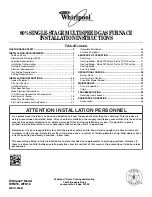
Page 63
Applications Using A Single-Stage Thermostat
See figure 55 for ignition control sequence
B - Heating Sequence -- Integrated Control Thermostat
Selection DIP Switch 1 ON in “Single-Stage” Position
NOTE - In these applications, two-stage heat will be initiat
ed by the integrated control if heating demand has not been
satisfied after the field adjustable period (7 or 12 minutes).
1. On a call for heat, thermostat first-stage contacts close
sending a signal to the integrated control. The inte
grated control runs a self‐diagnostic program and
checks high temperature limit switches for normally
closed contacts and pressure switches for normally
open contacts. The combustion air inducer is ener
gized at low speed.
2. Once the control receives a signal that the low pres
sure switch has closed, the combustion air inducer be
gins a 15-second pre-purge in low speed.
NOTE - If the low fire pressure switch does not close
the combustion air inducer will switch to high fire. After
a 15 second pre-purge the high fire pressure switch
will close and the unit will begin operation on high fire.
After 10 to 20 seconds of high fire operation the unit
will switch to low fire.
3. After the pre-purge is complete, a 20-second initial ig
nitor warm-up period begins. The combustion air in
ducer continues to operate at low speed.
4 - After the 20-second warm-up period has ended, the gas
valve is energized on low fire (first stage) and ignition oc
curs. At the same time, the control module sends a sig
nal to begin an indoor blower 30-second ON-delay.
When the delay ends, the indoor blower motor is ener
gized on the low fire heating speed and the HUM con
tacts are energized. The integrated control also initi
ates a second-stage on delay (factory-set at 7 min
utes; adjustable to 12 minutes).
5 - If the heating demand continues beyond the second-
stage on delay, the integrated control energizes the
combustion air inducer at high speed. The control also
checks the high fire (second stage) pressure switch to
make sure it is closed. The high fire (second stage)
gas valve is energized and the indoor blower motor is
energized for operation at the high fire heating speed.
6 - When the thermostat heating demand is satisfied, the
combustion air inducer begins a 5-second low speed
post-purge. The field-selected indoor blower off delay
begins. The indoor blower operates at the low-fire
heating speed.
7 - When the combustion air post-purge period is com
plete, the inducer, the HUM contacts as well as the
120V ACC terminals are de-energized. The indoor
blower is de-energized at the end of the off delay.
1 stg heat demand
2 stg heat demand
15
ON
OFF
ÉÉ
ÉÉ
low speed CAI
35
1
Pre-Purge
Ignitor Warm-up
30* second
blower
“on” delay
Post
Purge
5 SEC
80
ignitor
HEATING OPERATION WITH TWO-STAGE THERMOSTAT
low fire gas valve
indoor blower low heat
high speed CAI
high fire gas valve
indoor blower high heat
39
Trial For
Ignition
blower
“off”
delay
RECOGNITION PERIOD
30 seconds
FIGURE 54
* Conventional thermostat 30 seconds, icomfort Touch
®
thermostat set for 30 adjustable 15 to 45 seconds.
heat demand
15
ON
OFF
ÉÉ
ÉÉ
low speed CAI
35
1
Pre-Purge
Ignitor Warm-up
30* second
blower
“on” delay
Post
Purge
5 SEC
80
ignitor
HEATING OPERATION WITH SINGLE STAGE THERMOSTAT
low fire gas valve
indoor blower low heat
high speed CAI
high fire gas valve
indoor blower high heat
39
Trial For
Ignition
blower
“off”
delay
7 or 12 minutes after heating demand begins, furnace switches to high fire (depending on setting)
FIGURE 55
* Conventional thermostat 30 seconds, icomfort Touch
®
thermostat set for 30 adjustable 15 to 45 seconds.












































